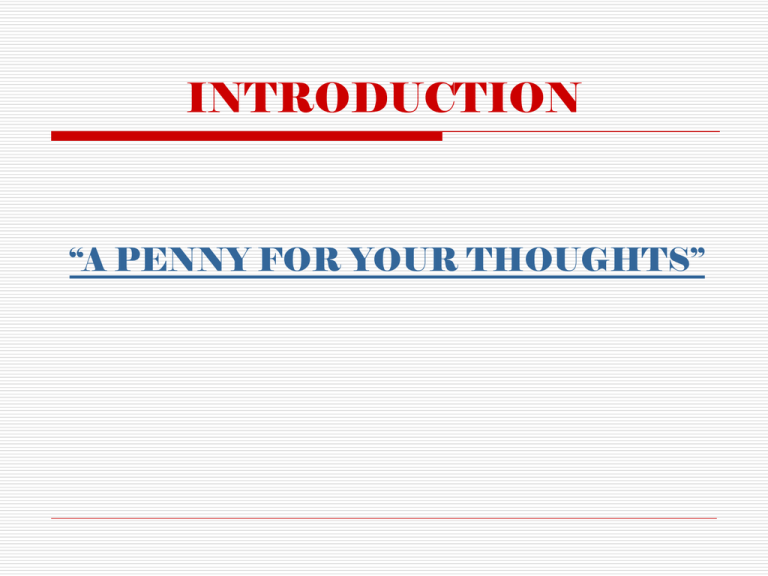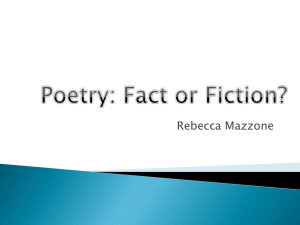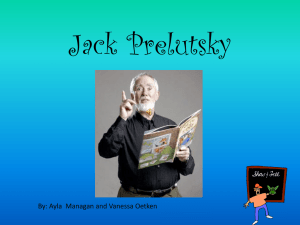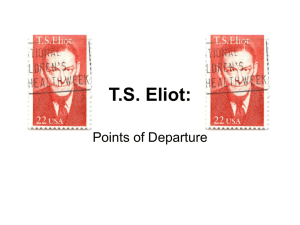POETRY THERAPY SEMINAR GUIDE
advertisement

INTRODUCTION “A PENNY FOR YOUR THOUGHTS” POETRY THERAPY SEMINAR GUIDE Conquering Adversity Through Verse A Lesson Plan By Todd Fries WHAT IS POETRY THERAPY? Poetry therapy is an interactive process with three essential components: the literature the trained facilitator and the client(s) A trained facilitator selects a poem or other form of written or spoken media to serve as a catalyst and evoke feeling responses for discussion. The interactive process helps the individual to develop on emotional, cognitive, and social levels. Writing original poems that at once speak to the unique and the universal is also part of the healing power of poetry and poetry therapy. GOALS OF POETRY THERAPY To develop accuracy and understanding in perceiving self and others; To develop creativity, self-expression, and greater self-esteem; To strengthen interpersonal skills and communication skills; To ventilate overpowering emotions and release tension; To find new meaning through new ideas, insights, and information; and To promote change and increase coping skills and adaptive functions. WHO ARE POETRY THERAPISTS? Poetry Therapy groups are run by writers, writer facilitators, psychological therapists, health professionals such as occupational therapists or nurses, social workers and teachers WHO CAN USE POETRY THERAPY? Poetry Therapy has a broad range of applications with people of all ages and is used for health and maintenance, as well as with individuals requiring treatment for various illnesses and conditions Examples are veterans substance abusers adolescents the learning disabled families with problems prisoners in rehabilitation the frail elderly the physically challenged survivors of violence, abuse and incest ROOTS OF POETRY THERAPY The use of poetry for healing purposes may be traced back to primitive man, who used religious rites in which shamans and witchdoctors chanted poetry for the well-being of the tribe or individual. It’s documented that as far back as the fourth millennium B.C.E. in ancient Egypt, words were written on papyrus and then dissolved into a solution so that the words could be physically ingested by the patient and take effect as quickly as possible. It is also recorded that around 1030 B.C.E., the music of a shepherd boy named David soothed the "savage breast" of King Saul. Historically, the first Poetry Therapist on record was a Roman physician by the name of Soranus in the first century A.D., who prescribed tragedy for his manic patients and comedy for those who were depressed. For many centuries the link between poetry and medicine remained obscure. ROOTS OF POETRY THERAPY In 1928, Eli Greifer, an inspired poet who was a lawyer and pharmacist by profession, began a campaign to show that a poem's didactic message has healing power. In the 1950's Griefer started a "poemtherapy" group at Creedmore State Hospital. In 1959, Greifer facilitated a poetry therapy group at Cumberland Hospital with two supervising psychiatrists, Dr. Jack J. Leedy and Dr. Sam Spector. Dr. Leedy published the first definitive book on poetry therapy in 1969, Poetry Therapy, which includes essays by many of the early pioneers in the field. About this time more and more people in the helping professions began to use poetry integrated with group process. Among them was Arthur Lerner, Ph.D. of Los Angeles who founded the Poetry Therapy Institute in the 1970’s on the west coast and in 1976 authored Poetry in the Therapeutic Experience. Finally, in 1980, a meeting was called to bring together those active in the field working all over the country to formulate guidelines for training and certification in poetry therapy and form what is now called the National Association for Poetry Therapy. HOW DOES POETRY THERAPY WORK? Receptive/prescriptive component involving the introduction of literature, poetry and song into therapy Expressive/creative component involving the use of creative writing in therapy Symbolic/ceremonial component involving the use of metaphors, rituals, and storytelling in therapy POETRY THERAPY SEMINAR The use of poetry in groups is extensive. Research shows that poetry therapy, helps group members develop sensitivity to group function and serves as a catalyst for advancing group process. The following is a basic structure of a poetry therapy seminar which uses a mixture of: 1)receptive/prescriptive exercises, 2)expressive/creative exercises and 3)symbolic/ceremonial exercises (as discussed above). The seven week/session format is based on a poetry therapy group model developed by Nicholas Mazza, Ph.D., R.P.T. (Registered Poetry Therapist). POETRY THERAPY SEMINAR The poetry therapy seminar schedule and activities should be set-up as follows: The group should convene for one session a week, for seven weeks. The group facilitator should ideally allow 1 – 2 hours for each session. Each session follows an identical structure: the session begins with 1) a warm-up activity, 2) followed by a reflection activity and 3) concludes with a group activity POETRY THERAPY SEMINAR Warm-up activities consist of different forms and methods of creative writing to get group members’ minds thinking, imaginations working and emotions flowing. Reflection activities employ pre-existing poems or pop music to be used by the group leader to facilitate discussion. Group activities are comprised of collaborative poems, whereby the group creates a poem with each member having the opportunity to contribute lines. Copies of the collaborative poem should be disseminated to the group and may be used for discussion at the beginning of the following session. HOW DOES THE GUIDE WORK? Each week is broken into its own color-coded section Every section starts with a form to be used by the facilitator/therapist for outlining goals of the upcoming session The activities for the week and directions for the activities follow Each section concludes with a leader report form which facilitators can use to chart group members’ progress and make notes about the session’s outcome and the session plan for the next week EXAMPLE OF GOAL SHEET WEEK ONE GOALS: EXAMPLE OF WARM-UP ACTIVITY WEEK ONE WARM-UP ACTIVITY: WHERE ARE YOU TODAY? The “Where are you Today” activity is a great ice-breaker with a group of strangers at the beginning of a new course. The goal of the activity is two-fold – to hear everyone’s voice, both literal and imaginative, and have everyone write something to build confidence in the group members’ abilities. The activity works like this: ask everyone “If they were a place, what place would they be?” Their answers could range from a room, to state, to a country, an even a planet. Give everyone 5 to 10 minutes to think about the question. Then ask people to pair up and introduce themselves to their partners as that place. For example, instead of Todd, I could be “Santa Clara University” or “California” or “San Francisco,” etc. Their partner is to ask them questions as if they were the place. For example, “How is the weather today?’ or “How do you feel when tourists come around?’ Allow each pair 5 to 10 minutes to get acquainted. Ask everyone to return to their seats and then take turns introducing their partner to the group as their place and add one or two things they learned from their conversation. For example, ‘this is Todd. He is Santa Clara University, hot and crowded.” Often mentioning places eases the group and delights some with the unexpected responses. Once everyone has been introduced, invite reflection on the activity. Invite everyone to write a few lines in their notebook, about the places they chose, how they described themselves or what they learned through the exercise. -Activity suggested by Victoria Field in Writing Works, Gillie Bolton, Victoria Field, Kate Thompson (2006) NOTES: WHY WARM-UP ACTIVITIES? The beginning of a new session arouses many new feelings and anxieties in participants and facilitators alike Warm-ups are designed to warm the ink in the pen, melt the resistance and reduce the level of anxiety EXAMPLE OF REFLECTION ACTIVITY WEEK TWO REFLECTION ACTIVITY: READ AND DISCUSS – POEM DISCUSSION A common technique of poetry therapy is reading a pre-existing poem with a group and inviting reactions and reflections. The poem may be introduced into the session to parallel the conversations or subject matter of the week or may be introduced to allow group members to make an emotional identification with the poem. Copies of the poem should be passed out to each group member for visual reference. Following the reading, the facilitator should lead a discussion focusing on what the poem means to the readers and which lines struck them as significant. Facilitators may also ask the group how they would change the poem if they were the author. Facilitators should allow 45 minutes for the activity. A comprehensive list of possible poems for use in therapy and possible discussion questions is included in the back of the guide. - Activity adapted from Poetry Therapy: Theory and Practice, Nicholas Mazza (2002) NOTES: WHY REFLECTION ACTIVITIES? Poems and songs can elicit emotional connections with the narrator or with fellow group members through discussion Songs and poems can allow group members to see how emotions may be expressed from different points of view REFLECTION ACTIVITY: COMPARE AND CONTRAST COMPARE: “The Road Not Taken” – Robert Frost WITH: “I Wandered Lonely as a Cloud” – William Wordsworth EXAMPLE OF GROUP ACTIVITY WEEK THREE GROUP ACTIVITY: CUTTING STRIPS Every now and then a trip away from the classroom can stimulate thought and inspire the group. “Cutting Strips” is an activity which begins with a field trip outside of the classroom to a designated location. Facilitators should choose a locale within a short distance from the classroom as the activity concludes with some classroom work. Any location will work, from a park to a parking lot. Ask the group to find a spot to sit and observe (observe includes hearing, seeing and feeling) their surroundings for 5 minutes. When the observation period ends, ask them to write 3 things they observed. For example a group member could write “someone down there is chopping wood” or “the valley hides under a gray blanket.” After the group members have finished writing their observations, everyone should return to the classroom. The facilitator should then pass out 3 strips of paper to each group member. The group members are to write one observation on each strip. The facilitator then collects the strips and reads the contents of each strip to the group. The strips should then be placed faced up in the center of the group and are to be collectively ordered to create a group poem. People may volunteer suggestions as to how the lines should be ordered or the facilitator can instruct the group to take turns. Often, having one’s line chosen by another when ordering the poem gives group members a sense of satisfaction and reassurance. When all the lines have been placed, the facilitator should read the completed poem aloud and the group should title the poem. A discussion of the poem and process should follow. The facilitator should allow 45 minutes to 1 hour for this activity. - Activity adapted from Poetry Activities – a Five Senses Approach, http://curriculalessons.suite101.com, James Parsons (2009) NOTES: WHY GROUP ACTIVITIES? Collaborative poems create group cohesion and maximize communication abilities Establish a culture of productivity and give encouragement to group members who have a hard time writing poems by themselves EXAMPLE OF REPORT FORM WEEK FOUR LEADER: POETRY THERAPY - LEADER REPORT FORM NOTES ABOUT GROUP MEMBERS: WARM-UP ACTIVITY NOTES: PRE-EXISTING POEM USED (TITLE): WHY?: COMMENTS: DATE: GROUP: REPORT FORM CONTINUED GROUP POEM (TITLE): COMMENTS: GENERAL IMPRESSIONS: HOMEWORK ASSIGNMENT: PLAN FOR NEXT WEEK (TOPICS, QUESTIONS, ETC.): MISCELLANEOUS: APPENDICES 22 poems most often used in practice Suggested songs for reflection activities Reflection activity discussion prompts Group activity discussion prompts Resources About the author MY GOALS FOR THIS PROJECT 1) To inspire therapists to become registered as poetry therapists and to use Poetry Therapy techniques in their practices 2) To give group facilitators the means to run an organized and effective Poetry Therapy seminar 3) To heal the world through poetry OUR CLASS GROUP POEM Another semester almost complete B C D E F G H I J K L M N O P Q R TITLE OUR CLASS GROUP POEM Law School Lore Another semester almost complete Bookstore no more Can’t believe I fell in love Deepening our understandings of each other’s struggles Exams are best administered open-book Finally finding my way out and graduating Grades are not everything Habeas corpus and Hambi v. Rumsfeld Illness seeps into my stomach at the thought of this experience ending for good Jobs are nowhere to be found Kitschy outfits worn at last month’s bar review Long distance relationship no more More to do Never out of debt Oh my goodness finals are approaching Prognosis hopefully successful Quite a joy to teach you all (W)Right are the professors who love you!







